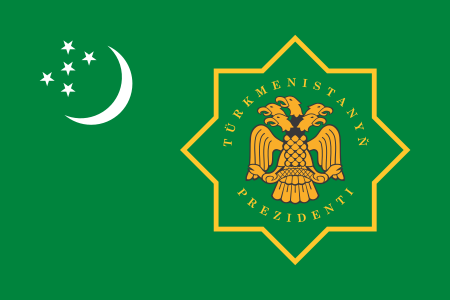Price
|
Read other articles:

拉尔·巴哈杜尔·夏斯特里第二任印度总理任期1964年6月9日—1966年1月11日总统薩瓦帕利·拉達克里希南前任古爾扎里拉爾·南達继任古爾扎里拉爾·南達印度外交部長任期1964年6月9日—1964年7月18日总理自己前任古爾扎里拉爾·南達继任斯瓦倫·辛格(英语:Swaran Singh)印度內政部長任期1961年4月4日—1963年8月29日总理賈瓦哈拉爾·尼赫魯前任戈文德·巴拉布·潘特(英语:Govind Ballabh …

العلاقات الألبانية الإسرائيلية ألبانيا إسرائيل ألبانيا إسرائيل تعديل مصدري - تعديل العلاقات الألبانية الإسرائيلية هي العلاقات الثنائية التي تجمع بين ألبانيا وإسرائيل.[1][2][3][4][5] ألبانيا لديها سفارة في تل أبيب وإسرائيل لديها سفارة في تي…

2016年美國總統選舉 ← 2012 2016年11月8日 2020 → 538個選舉人團席位獲勝需270票民意調查投票率55.7%[1][2] ▲ 0.8 % 获提名人 唐納·川普 希拉莉·克林頓 政党 共和黨 民主党 家鄉州 紐約州 紐約州 竞选搭档 迈克·彭斯 蒂姆·凱恩 选举人票 304[3][4][註 1] 227[5] 胜出州/省 30 + 緬-2 20 + DC 民選得票 62,984,828[6] 65,853,514[6] 得…

土库曼斯坦总统土库曼斯坦国徽土库曼斯坦总统旗現任谢尔达尔·别尔德穆哈梅多夫自2022年3月19日官邸阿什哈巴德总统府(Oguzkhan Presidential Palace)機關所在地阿什哈巴德任命者直接选举任期7年,可连选连任首任萨帕尔穆拉特·尼亚佐夫设立1991年10月27日 土库曼斯坦土库曼斯坦政府与政治 国家政府 土库曼斯坦宪法 国旗 国徽 国歌 立法機關(英语:National Council of Turkmenistan) 土�…

American musician (1950–1994) Dan HartmanPromotional photo for MCA Records, circa 1985Background informationBirth nameDaniel Earl HartmanBorn(1950-12-08)December 8, 1950West Hanover Township, Pennsylvania, U.S.DiedMarch 22, 1994(1994-03-22) (aged 43)Westport, Connecticut, U.S.[1]Genres Pop pop rock disco Occupation(s)MusiciansongwriterInstrumentsGuitarkeyboardsbassvocalsYears active1963–1994LabelsBlue SkyAtlanticMCAPrivateWebsitedanhartman.comMusical artist Daniel Earl Hartman (…

Village in Dorset, England Human settlement in EnglandLittlebredyParish church of St Michael and All AngelsLittlebredyLocation within DorsetPopulation121 [1]OS grid referenceSY588890Unitary authorityDorsetShire countyDorsetRegionSouth WestCountryEnglandSovereign stateUnited KingdomPost townDorchesterPostcode districtDT2PoliceDorsetFireDorset and WiltshireAmbulanceSouth Western UK ParliamentWest DorsetWebsiteVillage website List of places UK England…

Football tournament season 1877–78 Scottish CupThe Scottish Cup trophyTournament detailsCountryScotlandTeams116Defending championsVale of LevenFinal positionsChampionsVale of Leven(second title)Runner-up3rd Lanark RVTournament statisticsMatches played134Goals scored422 (3.15 per match)← 1876–771878–79 → The 1877–78 Scottish Cup – officially the Scottish Football Association Challenge Cup – was the fifth season of Scotland's most prestigious footba…

1938 Mickey Mouse cartoon Mickey's TrailerSuper 8 coverDirected byBen SharpsteenStory byJack KinneyProduced byWalt DisneyStarringPinto ColvigWalt DisneyClarence NashMusic byOliver WallaceAnimation byJohnny CannonClyde GeronimiEd LoveTom PalmerDon PattersonLouie SchmittFrenchy de TremaudanCy YoungLayouts byBill HerwigBackgrounds byBill HerwigColor processTechnicolorProductioncompanyWalt Disney ProductionsDistributed byRKO Radio PicturesRelease date May 6, 1938 (1938-05-06) [1&#…

عبد الرسول الإحقاقي معلومات شخصية الميلاد 12 أكتوبر 1928 الكويت تاريخ الوفاة 26 نوفمبر 2003 (75 سنة) مكان الدفن كربلاء الأولاد عبد الله الإحقاقي الأب حسن الإحقاقي تعديل مصدري - تعديل يفتقر محتوى هذه المقالة إلى الاستشهاد بمصادر. فضلاً، ساهم في تطوير هذه المق…

Artikel ini perlu diwikifikasi agar memenuhi standar kualitas Wikipedia. Anda dapat memberikan bantuan berupa penambahan pranala dalam, atau dengan merapikan tata letak dari artikel ini. Untuk keterangan lebih lanjut, klik [tampil] di bagian kanan. Mengganti markah HTML dengan markah wiki bila dimungkinkan. Tambahkan pranala wiki. Bila dirasa perlu, buatlah pautan ke artikel wiki lainnya dengan cara menambahkan [[ dan ]] pada kata yang bersangkutan (lihat WP:LINK untuk keterangan lebih lanjut). …

عينان مفتوحتانעיניים פקוחות (بالعبرية)Einayim Pkuhot (بالعبرية) غلاف الاصدار السنمائيمعلومات عامةالصنف الفني فيلم دراما[1][2][3] — فيلم متعلّق بالمثليين أو المتحولين — مشجاة المواضيع مثلية جنسية — يهودية حريدية تاريخ الصدور 2009 20 مايو 2010[4] (ألمانيا) مدة العرض 91 دقيق�…

David BrabhamBrabham in 2012Lahir5 September 1965 (umur 58)Wimbledon, London, England, United KingdomKarier Kejuaraan Dunia Formula SatuKebangsaan AustralianTahun aktif1990, 1994TimBrabham, SimtekJumlah lomba30 (24 starts)Juara Dunia0Menang0Podium0Total poin0Posisi pole0Lap tercepat0Lomba pertama1990 San Marino Grand PrixLomba terakhir1994 Australian Grand PrixCatatan lomba Le Mans 24 JamTahun1992–1993, 1996–2010, 2012TimTom Walkinshaw Racing, Gulf Racing/GTC Racing, David Price Racing,…

Clothing company For other uses, see White Stag. White StagCompany typeSubsidiaryIndustryApparelFounded1907HeadquartersUnited States ProductsSport clothing, sportswearParentWal-Mart Stores, Inc. White Stag is an in-store brand of women's clothing and accessories sold by Walmart. Founded as a skiwear manufacturer in Portland, Oregon, the company was purchased by the Warnaco Group in 1966, which in turn sold the brand to Wal-Mart in 2003. Company origins Tag from a Hirsch-Weis sleeping bagThe…

Transportasi di Malaysia mulai berkembang selama pemerintahan kolonial Inggris, dan jaringan transportasi di negara itu kini beragam dan berkembang. Jaringan jalan Malaysia sangat luas, meliputi 63.445 km, termasuk 1.630 km jalan tol. Jalan raya utama negara ini membentang lebih dari 800 km, mencapai perbatasan Thailand dan Singapura. Jaringan jalan di Semenanjung Malaysia adalah berkualitas tinggi, sementara sistem jalan di Malaysia Timur tidak seperti yang berkembang dengan baik…

Retreat center in Big Sur, California, US This article is about the non-profit institute. For the historical location, see Slates Hot Springs. Parts of this article (those related to reopening after the 2017 highway closure) need to be updated. Please help update this article to reflect recent events or newly available information. (November 2022) Esalen InstituteEsalen buildings and hot springsFounder(s)Michael MurphyDick PriceEstablished1962FocusHumanistic alternative educationPresidentGordon …

Jalan Tol Gedebage-Tasikmalaya-CilacapGedebage–Tasikmalaya–Cilacap Toll RoadJalan Tol GetaciAplikasi Pile Slab Sepanjang 9,12 kmInformasi ruteBagian dari Jalan Tol Trans JawaDikelola oleh BUJT (Dalam proses)Panjang:206.65 km (128,41 mi)Berdiri:Tahap 1(STA 00+000 – 108+300)Tahap 2(STA 108+300 – 206+650) – sekarangPersimpangan besarUjung Barat: Jalan Tol Padalarang–Cileunyi BIUTR/ Jalan Tol Dalam Kota Bandung Junction GedebageSimpang Susun MajalayaSimpang Susun NagregSimp…

Village in Villa Clara, CubaLa QuintaVillage [1]Nickname(s): Quinta, Quinto, Poblado la QuintaMap of La Quinta (Red) in Camajuaní (Orange) in Villa Clara (Yellow)La QuintaShow map of CubaLa QuintaShow map of Villa Clara ProvinceLa QuintaShow map of CamajuaníCoordinates: 22°30′30″N 79°45′46″W / 22.50833°N 79.76278°W / 22.50833; -79.76278CountryCubaProvinceVilla ClaraMunicipalityCamajuaníArea • Land0.3153 km2 (0.1217 sq …

Scientific naming of algae, fungi and plants For terminology used in describing plants, see Glossary of plant morphology. Botanical nomenclature is the formal, scientific naming of plants. It is related to, but distinct from taxonomy. Plant taxonomy is concerned with grouping and classifying plants; botanical nomenclature then provides names for the results of this process. The starting point for modern botanical nomenclature is Linnaeus' Species Plantarum of 1753. Botanical nomenclature is gove…

من الباندا والناس Of Pandas and People: The Central Question of Biological Origins معلومات الكتاب المؤلف دين كينون وبرسيفال ديفيس اللغة إنجليزية الناشر مؤسسة للفكر والأخلاق تاريخ النشر 1989 الموضوع تصميم ذكي التقديم عدد الصفحات 170 المواقع ردمك ISBN 0-914513-40-0 OCLC 27973099 تعديل مصدري - تعديل من الباندا و�…

Power outage in Italy and Switzerland This article has multiple issues. Please help improve it or discuss these issues on the talk page. (Learn how and when to remove these template messages) This article relies largely or entirely on a single source. Relevant discussion may be found on the talk page. Please help improve this article by introducing citations to additional sources.Find sources: 2003 Italy blackout – news · newspapers · books · scholar · JS…

